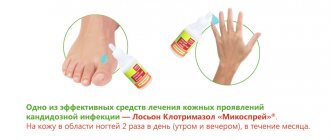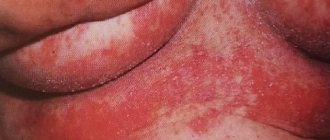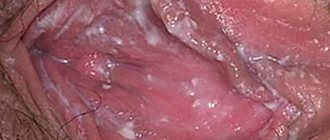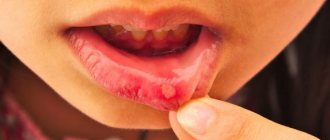Thrush, or candidal infection, accompanied by damage to the vaginal mucosa, is a problem for many women. The symptoms of this disease are so unpleasant that they completely knock the patient out of rhythm: due to severe itching, she cannot work normally, be sexually active, or even sleep peacefully.
THE COST OF AN APPOINTMENT WITH A GYNECOLOGIST IN OUR CLINIC IS 1000 rubles.
CLICK TO MAKE AN APPOINTMENT, TEST OR ULTRASOUND
Unfortunately, medications for thrush are advertised everywhere, which is why, having contracted candidiasis, women run not to the doctor, but to the pharmacy. After some time, the disease returns, which is natural, because such an infection cannot be cured with one pill; complex therapy is needed. That is why, at the first signs of thrush, you need to make an appointment with a good gynecologist and undergo full treatment. Today we will dispel myths about the treatment of thrush and formulate a number of recommendations that every woman should know.
How to cure thrush in women
Thrush (scientifically genital candidiasis) is a disease of the mucous membranes of the genital organs, which is caused by yeast-like fungi.
Thrush candidiasis is called because the disease is accompanied by pathological discharge from the genital tract, reminiscent of cottage cheese.
Candidiasis as a disease of the mucous membranes and skin poses a big problem for doctors of all specialties.
Genital candidiasis is a disease that is often chronic, recurrent, often accompanies pregnancy, and is associated with the menstrual cycle.
Causes
Reasons why thrush may occur in women:
- pregnancy;
- microflora disturbance;
- weakened immunity;
- endocrine diseases;
- use of contraceptives;
- failure to comply with hygiene standards.
Causes of thrush in men:
- failure to comply with hygiene standards;
- the result of unprotected sexual intercourse, transmission of the candida pathogen from a partner with thrush;
- sudden change in climatic conditions;
- use of aggressive detergents;
- weakened immunity;
- long-term use of antibiotics.
How to cure thrush in women?
In an advertisement for pimafucin, one of the drugs for the treatment of candidiasis, you will hear the following words: “Three days of using pimafucin and goodbye thrush!” In practice, it turns out that you will be treated with pimafucin, but the next menstruation will come and everything (recurrence of thrush) will happen all over again. What's the matter here? That the drugs don't work or are used incorrectly?
The point here is completely different. I want to make it clear right away that I have nothing against pimafucin. This is a good drug for the treatment of candidiasis. Only in order to understand why this disease lasts for a long time and recurs, you need to know the characteristics of the pathogen.
Is thrush contagious?
Keep in mind that candidiasis is a contagious disease and is easily transmitted to a sexual partner, so you will have to be treated together. The disease is often confused with an STD. In fact, thrush does not belong to this group, but contact with a man suffering from candidiasis will provoke the development of infection. A woman also transmits Candida to her partner. In men, thrush occurs more easily, this is due to good access of air to the mucous membrane of the head, but even without obvious signs, a once infected man becomes a carrier of the infection.
Pathogen
Candidiasis is caused by yeast-like fungi of the genus Candida in 90% of cases; other fungi of the genus Torulopsis are less common in pure culture or in association with Candida albicans.
Fungi of the genus Candida are aerobes, i.e. live in the presence of oxygen. Fungal flora is a saprophyte on the skin and mucous membranes of the mouth, intestines, and human reproductive system. Very often, fungal flora is found in practically healthy pregnant and non-pregnant women without signs of candidal colpitis.
Saprophytes are microorganisms that live off the nutrients of the environment and do not cause clinical disease under normal conditions, but if a person’s immunity decreases or other favorable conditions arise, such microorganisms acquire pathogenic properties and begin to cause diseases.
Fungi can enter a woman's genital tract from the intestines during sexual intercourse. But sexual transmission is not the main route, because A variety of factors contribute to the development of the disease. Candida fungal spores have a round shape; during an active inflammatory process, they form chains of pseudomycelium. Cells reproduce by budding.
What conditions contribute to the development of candidiasis?
- hormonal disorders
- metabolic disorders
- diabetes mellitus
- tuberculosis
- taking cytostatics
- taking antibiotics
- taking glucorticoids
- taking immunosuppressants
- taking oral contraceptives
- chronic colitis, gastritis
- B vitamin deficiency
- pregnancy
- HIV infection
- hepatitis
- in women with chronic inflammatory processes of the genital tract
- chronic inflammatory processes of the urinary system.
All these conditions or their combinations lead to the development of pathogenic properties of the fungal flora and clinical manifestations of candidiasis, and not only genital. I hope that it has now become clear why pimafucin, despite all its effectiveness, does not lead to a complete cure for the disease. Because if the conditions for activating the pathogenic properties of the pathogen are not removed from the body, the disease will constantly recur.
And the treatment of such a pathology should begin not locally, but systemically by identifying all the factors that support this process. Now it becomes clear that the low effectiveness of treatment for candidiasis during pregnancy, which is accompanied by immunodeficiency (otherwise it is simply impossible to carry a child to term, because it will be rejected by the mother’s body).
Candidiasis develops in women of all age groups: in puberty, in reproductive age, in postmenopause, but the reasons contributing to the maintenance of this condition may be different. In newborns, this is the result of infection while passing through the birth canal.
In children, this is a deficiency of estrogen (they don’t exist yet), which increases resistance to infection and contributes to the development of normal vaginal flora. During reproductive age, candidiasis often develops against the background of chronic inflammatory processes of the genitals, during pregnancy and in the presence of concomitant pathology. In the postmenopausal period, candidiasis is promoted by metabolic disorders, diabetes mellitus, deficiency of the same estrogen, but against the background of decreased hormonal function of the ovaries, the presence of chronic colitis, gastritis, etc. The incidence of candidiasis in Russia is 185 per 100 thousand population.
Conditions for effective treatment
Effective treatment for oral thrush involves eliminating the underlying cause. It is very important to sanitize the oral cavity: cure teeth destroyed by caries, remove non-viable teeth and roots that can no longer be restored. These are chronic foci of inflammation, so simultaneous sanitation will shorten the treatment time. Tartar and plaque should also be removed. This is especially true for cases of candidal stomatitis associated with injury to the gums by the sharp edges of hard dental deposits.
Patients with removable dentures should be re-trained in hygiene and disinfection of orthopedic structures. If the time to use a prosthesis comes to an end, it is important to replace it in a timely manner. Treatment of candidiasis will be useless if a person uses the denture incorrectly and again creates conditions in the oral cavity for the growth of fungi.
Unsuitable crowns, bridges and other structures must also be replaced. It is also important to eliminate chipped enamel, which becomes a source of injury to the gums, mucous membranes of the cheeks and tongue.
Smokers should reduce their smoking episodes if possible or quit the bad habit. If the disease has developed while taking corticosteroids, it is important to explain the rules of treatment: you should rinse the mouth with plenty of warm water after spraying the drug.
When treating oral candidiasis that has developed during antibacterial therapy, measures should be taken to restore the normal microflora of the intestine and oral cavity. You may need to consult another specialist or therapist: you will need to take probiotics and prebiotics.
For all patients treated for candidiasis, several general recommendations apply:
- maintaining oral hygiene;
- refusal of foods rich in carbohydrates;
- giving up sugary drinks.
It is necessary to exclude from the diet foods that can irritate the mucous membranes: dishes prepared with vinegar, marinades, spicy, peppery foods, smoked foods, sour fruits and berries. You should also not eat confectionery, baked goods made with yeast, or sugar. It is better to give preference to warm dishes. You need to follow this diet for another 1.5-2 months after recovery.
In some cases, it is advisable to use toothpastes with glucose oxidase, lysozyme, and lactoferrin. They help improve the defenses of the oral mucosa and can be part of a comprehensive prevention of inflammation. The choice of toothpaste should be agreed with your doctor; he will recommend the optimal product, and also tell you which brush is suitable.
Pathogenesis:
Candidiasis is an inflammation of the mucous membrane of the vagina, cervix, and external genitalia. The inflammatory process occurs against the background of decreased immunity, which causes the development of pathogenic properties of fungal cells. They begin to penetrate the mucous membranes of the host, causing itching, burning, and an inflammatory reaction.
In severe inflammation, the penetration of the pathogen can be very deep, right down to the muscle layer and the infection spreads throughout the body. The presence of a fungal infection causes severe allergies. Quite often, with chronic candidiasis, even eating yeast dough, sugar or beer can cause itching at the sites of candidal lesions.
Clinical picture
Clinical manifestations are itching, burning, pathological discharge - liquid, curdled, white or gray leucorrhoea with a sour, unpleasant odor.
When an infection enters the urinary tract, itching, burning, and pain occur when urinating. Itching is accompanied by insomnia, which leads to neuropsychic disorders.
The classic manifestation of the disease is white or gray plaque on the inflammatory mucous membranes of the genital tract. These deposits can be removed with a swab; under them you can often see an easily bleeding surface.
These plaques consist of pseudomycelium of the fungus, desquamated epithelium and leukocytes. The mucous membrane in the acute stage is hyperemic and edematous. In the chronic stage and with candidiasis, there may be no inflammatory changes. The course of the disease is long (months, years), recurrent, and difficult to treat. Often a dependence is established on the phases of the menstrual cycle or on the exacerbation of concomitant pathology.
Is thrush really a problem?
The content of the article
People of all ages suffer from candidiasis, with the peak incidence occurring between 20 and 40 years of age. According to statistics, 60% of women have been diagnosed with thrush at least once in their lives, and in 9%, candidiasis has a recurrent (repeating) course. In reality, this figure is higher, since in many patients the disease does not produce noticeable symptoms and the fungus is detected only when swabs are taken from the vagina.
The main problems of this pathology are self-medication, which leads to the disease becoming chronic, and negligent attitude towards one’s health. Gynecologists at the Diana Medical Center daily encounter cases of thrush, the severity of which is due to the patients’ late seeking of professional medical help.
Diagnostics
Diagnosis is most often not difficult.
Characteristic symptoms – itching, leucorrhoea, characteristic plaques – allow one to suspect the disease To confirm the diagnosis, microscopy of Gram-stained smears is used. PCR (polymerase chain reaction) is also used
Cultural method - inoculation on a nutrient medium.
Serological diagnostics and allergic skin test are also used Diagnosis should also include recognition of all conditions that may lead to relapse of the disease.
Attention! Detection of spores of yeast-like fungi in smears or urine in the absence of clinical symptoms is not an indication for treatment, because they can be periodically released in healthy people.
Tar soap
In order to know how to treat thrush with folk remedies, you need to know the properties of all components possible for use in treatment.
Tar soap is very useful for the treatment of many skin diseases, and is also suitable as a therapeutic and preventive remedy against thrush. It contains birch tar, an active component that destroys various types of fungi and bacteria.
During therapy, birch tar can be taken orally, 3 drops three times a day as an adjuvant.
The greatest effect is achieved when using tar soap in combination with other remedies for thrush. It is only suitable for washing; this procedure can be done twice a day. This therapy only helps relieve the symptoms of the disease, but is not a cure. As a preventive measure, you can use tar soap 1-2 times a week, but not more often, because it can dry out the skin.











